Caring for Petroliana
by Bob Brooke
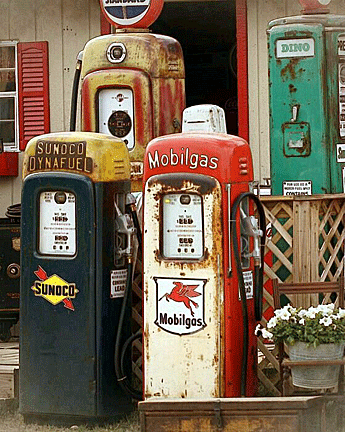 Metal
is the main material in most, but not all, petroliana items. Whether
you have old gas pumps, oil cans, or gas station signs, water is a
serious threat to any petroliana collection. Due to an oxidization
process, rust forms on moist metal objects after a matter of days.,
so it’s important to make sure that the items in your collection are
clean and protected. Metal
is the main material in most, but not all, petroliana items. Whether
you have old gas pumps, oil cans, or gas station signs, water is a
serious threat to any petroliana collection. Due to an oxidization
process, rust forms on moist metal objects after a matter of days.,
so it’s important to make sure that the items in your collection are
clean and protected.
Cleaning Light Rust
You should be careful when purchasing items that they don’t have too
much rust damage. In fact, you want to buy items in the best
condition possible. But even pristine items can be damaged over
time. So it’s vitally important not to store your petroliana
collection in your unheated garage or basement. Make sure wherever
you display it is free from humidity. If there’s even a slight
chance of dampness, rust will form faster than you can imagine.
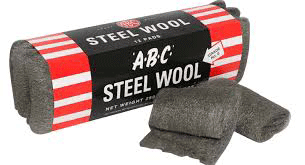 To
clean light rust from your metal items, you’ll need some common
materials—steel wool, a wire brush, some fine sandpaper, or a
crumpled ball of aluminum foil. You can use these to brush away
small rust stains with ease. Carefully rub the surface with some
pressure to effectively clear away the rust. Since the paint surface
of metal petroliana objects is one of their most important
characteristics, you’ll want to be very careful. To
clean light rust from your metal items, you’ll need some common
materials—steel wool, a wire brush, some fine sandpaper, or a
crumpled ball of aluminum foil. You can use these to brush away
small rust stains with ease. Carefully rub the surface with some
pressure to effectively clear away the rust. Since the paint surface
of metal petroliana objects is one of their most important
characteristics, you’ll want to be very careful.
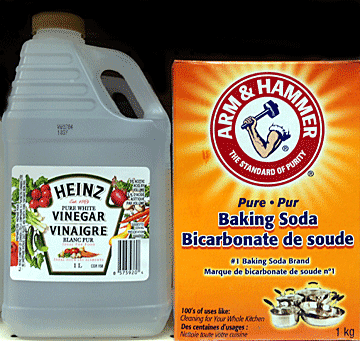 You
may also want to try using vinegar or lemon juice and salt. Either
of these materials work well for removing rust as their acidic
properties help to dissolve the stain. White vinegar, or acetic
acid, and lemon juice, or citric acid, are both weak acids, which
loosen the rust. You
may also want to try using vinegar or lemon juice and salt. Either
of these materials work well for removing rust as their acidic
properties help to dissolve the stain. White vinegar, or acetic
acid, and lemon juice, or citric acid, are both weak acids, which
loosen the rust.
If you decide to use lemon juice, pour a tablespoon of it on the
rust. Apply about a half teaspoon of table salt and then apply
another tablespoon of lemon juice on the salt. Make sure you use
enough of both to thoroughly coat the rust stain. Or you can
substitute the vinegar for the lemon juice, but the method is the
same.
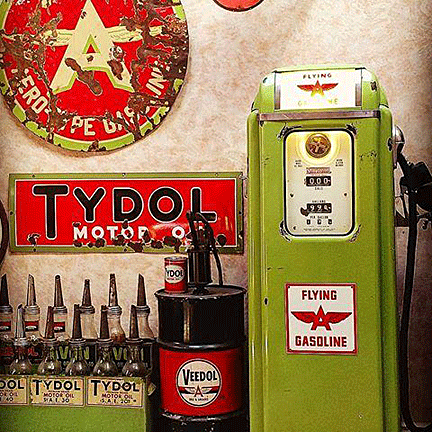 Next,
wipe off the lemon juice or vinegar with a clean cloth. Make sure
you use a clean cloth so no other contaminants get onto the stain.
Thoroughly rinse the stain afterwards and scrub vigorously to remove
any remaining rust. Then wash the piece or thoroughly wipe off the
treated area with a clean wet cloth. It's very important to clean
the surface with water after the rust has dissolved. If any vinegar
or lemon juice is left on the tinware the acidity could damage the
metal. Next,
wipe off the lemon juice or vinegar with a clean cloth. Make sure
you use a clean cloth so no other contaminants get onto the stain.
Thoroughly rinse the stain afterwards and scrub vigorously to remove
any remaining rust. Then wash the piece or thoroughly wipe off the
treated area with a clean wet cloth. It's very important to clean
the surface with water after the rust has dissolved. If any vinegar
or lemon juice is left on the tinware the acidity could damage the
metal.
A third way to clean rust stains from items in your collection is to
make a paste by mixing equal parts baking soda and water. Start by
mixing 1 tablespoon of baking soda and 1 tablespoon of water with a
spoon in a small bowl. Combine more if necessary. It's important to
make sure the paste is thick enough to adhere to the rust.
Apply the paste with a clean, wet rag. Using the rag, apply the
paste and allow it stick to the rusted surface for a few hours or
longer. Be sure to give the mixture enough time to set on the rust.
Protecting Your Pieces
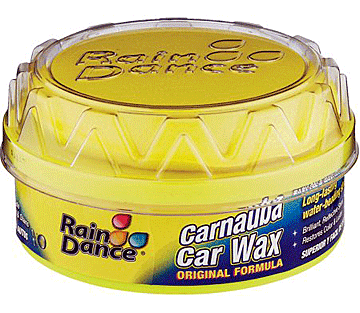 After
you’ve cleaned the rust and let the piece dry thoroughly, you should
give it a coat of Minwax paste wax. Some collectors use an
automotive paste wax like Raindance. Apply either in a small,
circular motion, using a lighter touch to begin and gradually
becoming more aggressive as you go. Let the wax dry, then wipe it
off with a clean, soft cloth. After
you’ve cleaned the rust and let the piece dry thoroughly, you should
give it a coat of Minwax paste wax. Some collectors use an
automotive paste wax like Raindance. Apply either in a small,
circular motion, using a lighter touch to begin and gradually
becoming more aggressive as you go. Let the wax dry, then wipe it
off with a clean, soft cloth.
You can also wipe your items with Armor-All. Be sure to spray the
Armor-All on a clean, soft cloth, then wipe the piece. Do not spray
it directly on it.
<
Back to Caring for Your Collections
Archives
Next
Article > |
